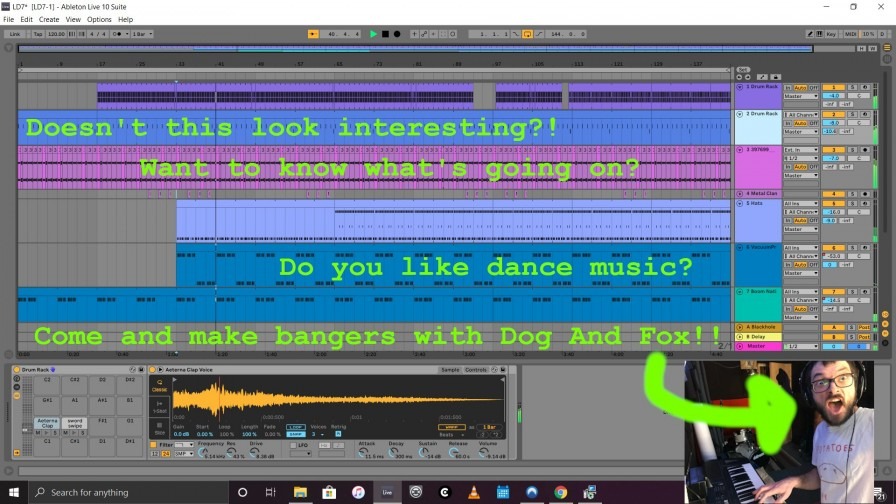Electronic Music Making Online during Lockdown

I’m Jack, a self-employed musician, based in Gateshead. Over the past 15 years I’ve written and produced music for film, theatre and dance. I perform across the world in a touring street theatre show called Spark! as well as closer to home with the Maracatu and Samba bands affiliated with Jack Drum Arts; Baque de Ogum and Runaway Samba. In my own time I produce electronic music and have released albums and EPs with record labels in USA, New Zealand and the UK.
The global pandemic and subsequent lockdown brought my touring work as a drummer to a shuddering halt. In early March I had lots of gigs lined up over the summer and into the autumn. By the 14th these had all been cancelled and I was looking for work.
With the closing of schools and then lockdown Jack Drum Arts wanted to find a way to support young people, not only those they already worked with, but others from across the County who had not engaged with the organisation before. It seemed a great opportunity to offer an online course to teenagers in rural County Durham, looking at the writing and producing of Electronic Music.
I have been making music using computers for almost 20 years but my teaching in the field had been limited to one day courses, with little time to go into detail about the inner workings of the software and how to manipulate it to achieve results. An online music making course was a great opportunity for myself to condense my knowledge into lessons and learn more about my own practice in the process.
So…to the course.
I ran the course online, screen sharing in a weekly Zoom meeting and teaching the foundations of making Electronic Music in a Digital Audio Workstation (DAW). None of the participants had previous experience working with professional standard DAWs or creating Electronic Music. The participants held on tight as they took a leap into the unknown - each DAW has its own unique user interface. Session one was dedicated entirely to explaining the user interface, workflow and operation of the software and its components.
Some feedback from the participants and their parents; “it helped massively as it helped break the monotony of lockdown as I was contributing to something.” “I’m now comfortable with this sort of software and can experiment with it independently at home.” “really enjoyed it as I was exposed to new influences” “learnt how to be a part of a group and how to compromise on my own ideas. It was also good to have so many things explained.” “Thank you Jack and Sam for passing on your obvious enthusiasm.”
Working in Ableton, I taught the basic principles of synthesis, audio editing, midi programming, audio effects, arrangement, and mixing. There is so much that goes into making a track. The participants have made executive decisions throughout in choosing the chord sequences, melodic and harmonic lines, bass lines and drum patterns in the tracks we worked on, as well as shaping the sonic properties of the instruments and samples we used.
Looking at synthesis, we examined the tonal properties of the different oscillators from Ableton’s stock software synths. We explored the ADSR envelopes of the amplifier and filters and used LFOs to give our synth sounds rhythmic variation. We programmed these synths to play melodies and chord sequences, and then spent time sculpting and shaping the timbre and tonality of the sound we hear. The participants learnt about the frequency range, in which pitch is visualized on a horizontal scale. This is most often seen in an EQ audio effect, used to highlight or dampen certain frequencies
We worked with raw audio, recording instruments including guitar and melodica. We also imported samples into our tracks and manipulated them in a variety of ways to create lots of interesting noises, from glitched sounding audio to re-pitched vocals. Participants learnt about the endless potential for reinvention when working within a DAW.
We used a range of audio effects to process sounds, including reverbs, delays, EQs and compressors. Through using these effects in send channels, participants learnt about the overall sonic universe of the track and how to best achieve a clear mix. We used specific reverb and delay effects on individual tracks to achieve specific sounds, but they learnt of the potential muddying of a mix through the use of multiple reverb effects.
Throughout the course we discussed mixing as and when the issue has arisen. Built into each discussion about volume level was a consideration about panning and where each sound should sit in the stereo field. Throughout the course participants made valuable suggestions for volume levels and panning.
We created a lot of material in the course, developing three ideas into the beginnings of fully fledged tracks. Some ideas didn’t make it past the embryonic phase. The participants took the lead in deciding which of our ideas we would develop further into tracks, through this process they engaged in constructive criticism, an important skill to have in any creative discipline.
I had a thoroughly enjoyable time working with the group and sharing my knowledge of music production within a DAW. It has been wonderful to be part of the journey taken by Jack Drum Arts over the last 6 months developing an online programme to reach out to vulnerable young people during the pandemic crisis. Alongside the music making aspect of the sessions it also provided much needed support, a virtual place for young people to come together weekly to connect and have fun. I look forward to following the participants as they continue their own musical journeys and will hopefully see them face to face in the not to distant future.
Jack Burton, August 2020

